GARDEN OF HOPE IN THE DESERT
Jardín de Esperanza en el Desierto (Spanish)
By Mary Hunt Webb
Posted Saturday, August 13, 2011
In previous years, I listened to friends talk about the tomatoes that they grew and wondered how they did it.
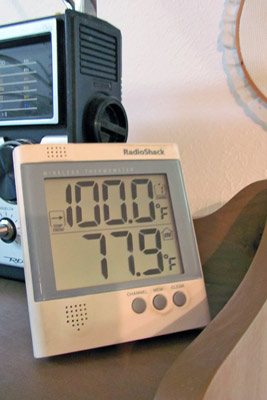
The higher number on our digital thermometer shows the first day this summer that our outdoor temperature reached 100 degrees Fahrenheit. The lower number was our indoor temperature. [Photographer: Mary Hunt Webb]
Between our poor sandy soil, the punishing heat, and the lack of humidity, I was seldom able to get tomato plants to survive! The few that did survive produced small fruit.
Then, something happened last year. Of the ten young tomato plants that I purchased from a nursery, one survived while two that I planted from seed survived as well. All three survivors were in pots while the others had been in the ground.
Aha! Pots! I vaguely remembered seeing tomato cages on the balcony of a former neighbor and thinking at the time, “Is he growing tomatoes up there?” Now I know that he was growing them in pots!
This year, I bought three large, plastic pots and used a fourth large terra cotta pot that I already had. To the first plastic pot, I added all sorts of amendments, such as blood meal and plant food. When I ran out of potting soil, I went to the nursery for more. However, I made the mistake of telling the nurseryman about the additions I had made.
“Oh, you don’t need to add those things,” he admonished. “That stuff is already in the potting soil mix!”
I shouldn’t have listened to him, but I did. I only used the potting soil mix in the three remaining pots. Now the first pot has six tomato plants growing in it after I weeded some of them out!
Among the other three pots, I have seven more plants in various stages of growth. Some plants have blossoms while several green tomatoes have already appeared.
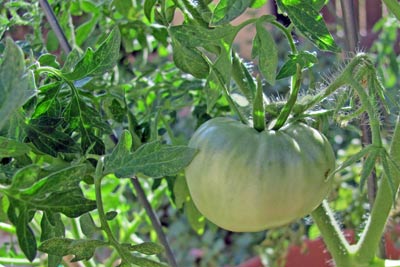
This green tomato is the promise of good meals that await us in the weeks ahead. [Photographer: Mary Hunt Webb]
Rather than purchasing seedlings this year, I planted four different types of tomatoes from seed. The idea was that if one variety of tomato did not do well in our difficult climate, another type might survive. I also planted some carrots as well. Next year, I will try to remember to add amendments to all the pots, no matter what the nurseryman says!
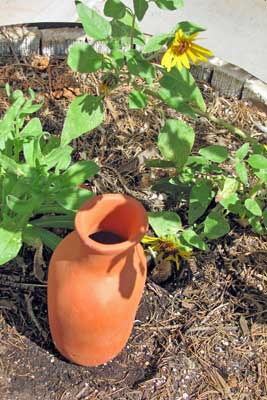
This is what one olla pot looked like before I buried it in the soil in a big flowerpot. Most ollas are short and round while this one is elongated. [Photographer: Mary Hunt Webb]
If I were only watering the pots with a hose, I might not be having success, but I also bought four terra cotta olla (oh’-ya) pots, such as the one you see in the photo above. I buried one in the middle of each large flowerpot, as you see in the following photo, and filled the ollas with water. As the water seeps out through the porous clay of each olla, I refill them as needed. I also give the vegetables plant food every week or two.

After an olla nestles into the center of a pot, it almost disappears among the plants. [Photographer: Mary Hunt Webb]
While we look forward to eating what I have grown, gardening isn’t only about growing produce. One person said, “I can buy tomatoes in the store, spend less money, and save time!” That may be true. The money that I spent on flowerpots, olla pots, potting soil, and water this year probably makes this first crop expensive, but the cost will go down next year because I will already have everything except the potting soil and the seeds. The main reason for planting is that I know that the taste of a homegrown tomato is superior to that of a purchased one from the supermarket. The taste will tell me that I did the right thing in growing my own.
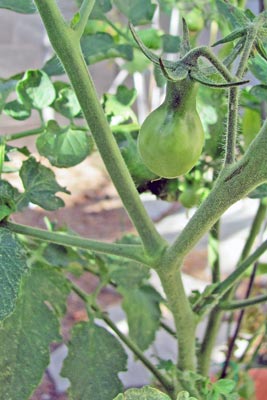
As it grows, this will ripen into a small Yellow Pear Tomato. [Photographer: Mary Hunt Webb]
I also have the advantage of having planted at least two varieties that are not available in the supermarket, such as the young pear tomato pictured above. I can’t wait to taste all the varieties!
There is also the feeling of victory in overcoming adverse conditions with tangible evidence of my success. There are so few areas left unconquered that we must find them where we can.
Gardening is also learning. My favorite gardening quote is from Thomas Jefferson, third President of the United States from 1801-1809. He once said, “I may be an old man, but I am a young gardener!” Imbedded in that statement is the declaration that as long as one keeps gardening, one will continue to learn. Studies have shown that those that continue to learn are staving off dementia and Alzheimer’s disease.
Lastly, with the economy in the awful shape it is in and so much bad news all around, there is encouragement in being able to do something positive and grow flowers, food, and herbs that are so beautiful! Praise God that plants can’t hear the dire news so they keep right on growing! That’s because only corn has ears!
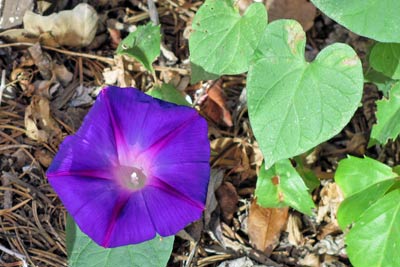
The purple Morning Glory shows its cheerful blossoms every morning. [Photographer: Mary Hunt Webb]
Luke 12:27-28 “27) Consider the lilies, how they grow: they neither toil nor spin; and yet I say to you, even Solomon in all his glory was not arrayed like one of these. 28) If then God so clothes the grass, which today is in the field and tomorrow is thrown into the oven, how much more will He clothe you, O you of little faith? (New King James Version)
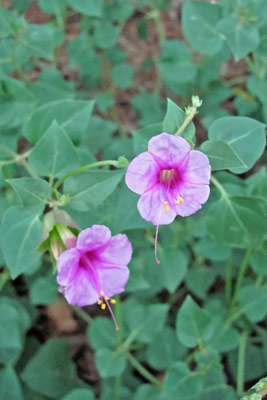
This Desert Four O’Clock delights us every afternoon with its beautiful blossoms that remain open even after the sun has set. [Photographer: Mary Hunt Webb]
Lucas 12:27-28 “27) Considerad los lirios, cómo crecen; no trabajan, ni hilan; mas os digo, que ni aun Salomón con toda su Gloria se vistió como uno de ellos. 28) Y si así viste Dios la hierba que hoy está en el campo, y mañana es echada al horno, ¿cuánto más a vosotros, hombres de poca fe?” (Reina-Valera 1960)

